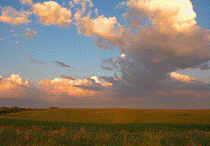North American Prairie Conference
Date of this Version
1989
Abstract
Early surveyors' notes from five counties bordering the Platte River in eastern Nebraska were utilized to measure the extent of original woody vegetation in this region. These data were compared to field studies from the same area made from 1979-1983, were used to determine areas of prairie-forest transition, and were used to tabulate the extent of woody vegetation in the lower Platte River Valley at the time of European settlement (1855-1857). Using a modified importance value based on relative density and relative dominance of witness trees, the highest ranking pre-settlement tree species were cottonwood [Populus eltoides Marsh. spp. monilifera (Ait.) Eckenw.], bur oak (Quercus macrocarpa Michx.), elms (Ulmus spp.), willows (Salix spp.), and black oak (Quercus velutina Lam.). The original survey indicated the presence of single trees and tree clusters within the original prairie vegetation of eastern Nebraska. Trees are presently more widespread, and their composition differs from the original woody vegetation. Presently, cottonwood, bur oak, American linden (Tilia americana L.), and rough-leaved dogwood (Cornus drummondii Meyer) are more common than they were 130 years ago.


Comments
Published in Prairie Pioneers: Ecology, History and Culture: Proceedings of the Eleventh North American Prairie Conference, August 7-11, 1988, Lincoln, Nebraska (Lincoln, NE 1989).